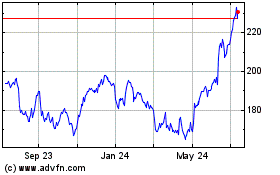By Katie Deighton
Dagmar Munn and her husband purchased a smart speaker from
Amazon.com Inc. for their home in Green Valley, Ariz. in 2017,
seven years after Ms. Munn was diagnosed with amyotrophic lateral
sclerosis, the motor neuron disease more commonly referred to as
ALS.
At first the speaker's voice assistant, Alexa, could understand
what Ms. Munn was saying. But as her condition worsened and her
speech grew slower and more slurred, she found herself unable to
communicate with the voice technology.
"I'm not fast enough for it," Ms. Munn said. "If I want to say
something like 'Alexa, tell me the news,' it will shut down before
I finish asking."
Ms. Munn can't interact with voice assistants such as Alexa
because the technology hasn't been trained to understand people
with dysarthria, a speech disorder caused by weakening speech
muscles. People with a stutter or nonstandard speech caused by
hearing loss or mouth cancer can also struggle to be understood by
voice assistants.
Approximately 7.5 million people in the U.S. have trouble using
their voices, according to the National Institute on Deafness and
Other Communication Disorders. Julie Cattiau, a product manager in
Google's artificial intelligence team, said that group is at risk
of being left behind by voice-recognition technology.
Google is one of a number of technology companies now trying to
train voice assistants to understand everyone.
Some made investments into voice accessibility after realizing
that people with dysarthria -- often a side effect of conditions
including cerebral palsy, Parkinson's disease or a brain tumor --
may be the group that stands to benefit most from voice-recognition
technology.
"For someone who has cerebral palsy and is in a wheelchair,
being able to control their environment with their voice could be
super useful to them," said Ms. Cattiau. Google is collecting
atypical speech data as part of an initiative to train its
voice-recognition tools.
Training voice assistants to respond to people with speech
disabilities could improve the experience of voice-recognition
tools for a growing group of potential users: Seniors, who are more
prone to degenerative diseases, said Anne Toth, Amazon's director
of Alexa Trust, a division that oversees the voice assistant's
privacy and security policies and features, as well as its
accessibility efforts.
Amazon in December announced an Alexa integration with Voiceitt,
an Israeli startup backed by Amazon's Alexa Fund that lets people
with speech impairments train an algorithm to recognize their own
unique vocal patterns. Slated to go live in the coming months, the
integration will allow people with atypical speech to operate Alexa
devices by speaking into the Voiceitt application.
Apple Inc. said its Hold to Talk feature, introduced on
hand-held devices in 2015, already lets users control how long they
want the voice assistant Siri to listen for, preventing the
assistant from interrupting users that have a stutter before they
have finished speaking.
The company is now researching how to automatically detect if
someone speaks with a stutter, and has built a bank of 28,000 audio
clips from podcasts featuring stuttering to help do so, according
to a research paper due to be published by Apple employees this
week that was seen by The Wall Street Journal.
The data aims to help improve voice-recognition systems for
people with atypical speech patterns, an Apple spokesman said. He
declined to comment on how Apple may use findings from the data in
detail.
Google's Project Euphonia initiative is testing a prototype app
that lets people with atypical speech communicate with Google
Assistant and smart Google Home products by training software to
understand their unique speech patterns. But it's also compiling an
audio bank of atypical speech that volunteers -- including Ms. Munn
-- contribute to.
Google hopes that these snippets will help train its artificial
intelligence in the full spectrum of speech and bring its voice
assistant closer to full accessibility, but it isn't an easy task.
Voice assistants can recognize most standard speech because users'
vocal harmonies and patterns are similar, despite their different
accents. Atypical speech patterns are much more varied, which makes
them much harder for an artificial intelligence to understand, said
Google's Ms. Cattiau.
"As of today, we don't even know if it's possible," she
said.
Critics say technology companies have been too slow in
addressing the issue of accessibility in voice assistants, which
first became available around 10 years ago.
Glenda Watson Hyatt, an accessibility advocate and motivational
speaker who has cerebral palsy, said some disability surveys don't
report on the prevalence of speech disabilities, so if technology
companies "relied on such data to help determine market size and
needs, it is obvious why they overlooked or excluded us."
People working in voice accessibility say the technology only
relatively recently became sophisticated enough to attempt handling
the complexities of nonstandard speech. They also said many
technology firms weren't placing so much emphasis on inclusive
design when the first voice assistants were being built.
Contributing to projects such as Project Euphonia can also be
difficult for people with atypical speech. Ms. Munn says she
sometimes finds speaking physically exhausting, but is happy to
contribute if it helps teach a voice assistant to understand
her.
"It would help me feel normal," she said.
Write to Katie Deighton at katie.deighton@wsj.com
(END) Dow Jones Newswires
February 24, 2021 12:15 ET (17:15 GMT)
Copyright (c) 2021 Dow Jones & Company, Inc.
Apple (NASDAQ:AAPL)
Historical Stock Chart
From Mar 2024 to Apr 2024

Apple (NASDAQ:AAPL)
Historical Stock Chart
From Apr 2023 to Apr 2024
